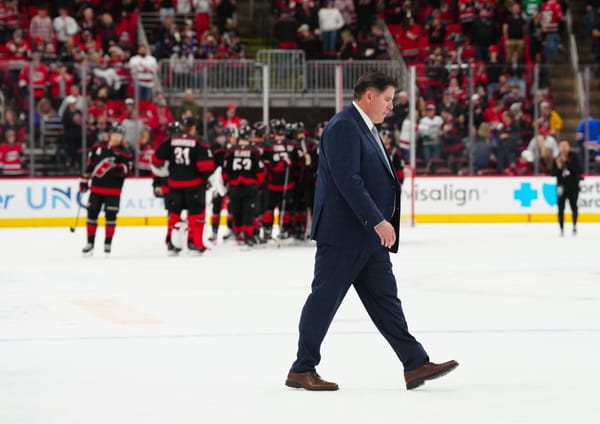To Buy or Not To Buy? The Rangers Must Answer
With a playoff berth all but assured already, Chris Drury must decide how much of the future he’s willing to sacrifice to improve the team now
With the trade deadline less than a week away, the New York Rangers find themselves back in a spot they used to occupy on a regular basis. With a 16 point cushion between them and the ninth ranked team in the Eastern Conference playoff picture, Gerard Gallant has all but assured a return to the Stanley Cup Playoffs in first season behind New York’s bench. While overcoming the eight point deficit for a division championship would be a tall order, the Blueshirts are in a dogfight for a second place finish in the Metropolitan Division and the home ice advantage in the first round that comes with that.
Being in playoff position as the trade deadline approaches was once familiar territory for the Rangers. Keith Yandle, Martin St. Louis, and Bryan McCabe represent a handful of big names the Blueshirts have surrendered draft picks to acquire in years past in the name of loading up with eyes on a championship.
However, the last few trade deadlines have seen the team operate as sellers. Veterans from championship contenders past departed, and draft picks and prospects arrived. Ryan Lindgren and Libor Hajek were prospects targeted by New York, while Braden Schneider, K’Andre Miller, and Nils Lundkvist were all selected by the Rangers using draft picks acquired via trade.
The team’s first playoff berth since 2017 is basically locked in already, so preparing for the postseason comes into focus. Igor Shesterkin’s heroics this season have vaulted him into the Hart Trophy conversation, rarefied air for a goaltender to be in. The eighth best penalty killing unit does its job, while Chris Kreider’s league leading 19 power play goals have helped the Rangers be the second most efficient team with the man advantage this season.
Unfortunately, the Blueshirts have been one of the league’s worst teams at five on five thus far. The team ranks 24th in Expected Goals% (46.79, sandwiched between Chicago and San Jose) and an absolutely ghastly 29th in Corsi For% (45.47, sandwiched between Montreal and Detroit). Last year’s team, a squad that no one would confuse for a Stanley Cup contender, finished 19th and 23rd in those metrics during the truncated 56 game campaign.
While it’s not impossible for Gerard Gallant to whip the team into shape in time for the playoffs, history isn’t on the Rangers’ side. Dating back to 2007-08, only four of the 28 Stanley Cup finalists have been sub-50% in the shot attempt battle over the course of a full season, with two of those four finalists (2008-09 Penguins and 2019-20 Stars) firing their coaches mid-season. Out of those four finalists, the only team also below the 50% mark in the scoring chance battle were the 2017-18 Capitals, who still posted marginally better numbers across the board than the current Rangers’ squad.
Much has been made of the recent struggles of Artemiy Panarin, as well as the top defensive pairing of Lindgren and Adam Fox, but the team’s struggles at five on five can be figured out with a cursory glance at the rest of the lineup. Nearly half of the team’s forwards are playing in roles over their heads. Whether it’s players better suited for fourth line duty like Dryden Hunt and Barclay Goodrow getting top six minutes, or AHL-quality players like Greg McKegg and Jonny Brodzinski filling out the bottom six, the forward corps isn’t up to snuff.
Given that situation, trades seem like the logical answer to remedy that issue. There’s no shortage of high end forwards available. Whether it’d be acquiring a pending unrestricted free agent as a pure rental or a player with some measure of control, be it a contract beyond this season or upcoming restricted free agency, teams in need of an extra forward or two will have their pick of the litter.
A player like Nashville’s Filip Forsberg, San Jose’s Tomas Hertl, or Philadelphia’s Claude Giroux could be the final piece to help push an upper echelon contender over the top with no obligation to them beyond this season necessary. Vancouver’s J.T. Miller and Montreal’s Artturi Lehkonen headline the list of forwards available for more than a single playoff run. Any one of them would be a massive help to New York’s cause. Even in spite of that, ponying up the necessary assets to land one of these top end players isn’t something that should be in the cards.
The Rangers are where are they are on the back of Igor Shesterkin. If this was a team capable of trading chances with the league’s best, there’d be a convincing argument to push most of the team’s chips into the middle of the table and hoping Shesterkin can keep up his historic play deep into the spring. But aside from a month’s long stretch from the middle of November through December, the Rangers have been trading punches with the league’s punching bags and getting outright dominated by the Calgary’s, Carolina’s, Colorado’s, and Pittsburgh’s of the league.
This isn’t a team one or two impact forwards away from being a contender. Given their grievous struggles at 5 on 5, MVP-level goaltending most nights, and even the highly likely first round matchup looming with the Penguins, this Rangers team feels eerily similar to the 2015-16 edition. That team gave up a pair of 2nd round picks and then-highly touted prospect Aleksi Saarela to rent Eric Staal for what ended up being a first round embarrassment that saw the Penguins outscore them 21-10 in five games and make them the first victim of what would become nine consecutive playoff series victories.
Bargain bin shopping isn’t the sexiest solution, but it’s arguably the one that makes the most sense for the Blueshirts, and there could be solid options available. The Rangers have been linked to Arizona’s Phil Kessel, who while no longer the explosive offensive threat he once, is still a capable right handed shot with an allegedly cheap asking price of a 3rd round draft pick.
There have been loose rumors of Gerard Gallant wanting to bring in Reilly Smith from Vegas, the brother of former Ranger Brendan Smith. While the Golden Knights are in the thick of the fight for playoff seeding, the team needed to place captain Mark Stone on LTIR in order to activate Jack Eichel off LTIR and remain cap compliant. The prevailing thought at the time was that Stone would be activated for Game 1 of the playoffs when the salary cap was no longer a factor. With a playoff berth now in question, it’d be worth seeing if Vegas is interested in selling low on Smith in order to make room for Stone to return sooner, provided he’s healthy enough to do so.
Much has been made of the amount of cap space the Rangers have available to them, and that can be being taken fully advantage of. Kessel’s $6.8 million cap charge could be cumbersome to other teams and require Arizona to retain salary to facilitate a trade, but that wouldn’t be necessary for New York. Vegas being able to clear the remainder of Smith’s $5 million cap charge would be a massive help in getting Stone back into the lineup before the playoffs if necessary.
The Rangers could also serve as a salary retaining middle man, accumulating extra draft picks and keeping potential rentals out of the East for doing so. That wouldn’t be unprecedented for a playoff bound team, as Vegas served as middle man in a 2018 Derick Brassard deal between Ottawa and Pittsburgh in order to add an extra draft pick as well as prevent the Winnipeg Jets from landing Brassard instead.
Chris Drury’s first trade deadline as the top decision maker on Broadway is upon us. With a plethora of excellent forwards available and more than enough holes in need of plugging, shelling out high end assets for one or more of those forwards will be tempting. If a deal can be swung without giving up a 1st round pick or top prospect, the Rangers should be all over it. If not, Drury will need to fight off some degree of playoff fever and avoid landing the big fish sand saving his bait for another day.





